Instructions: You learned about how businesses use capital budgeting tools to evaluate long-term investment decisions. We may be using these techniques (even if subconsciously) to make some personal life decisions. In this discussion. I encourage you to think about one such decision: your decision to attend UTRGV. Attending college has direct and opportunity costs, and you expect to benefit from this decision in the future. Think about and note down the following. Use rough approximations. 1. What is your cost of attending college?: What are you giving up by attending college for this 4 or 5 years? o Direct costs: tuition, books, accommodation, anything else you would not have spent if you did not go to college)...? o Opportunity costs: would you be making (more) money from a job if you were not attending college? How much more? Note down the following (again, approximately Total direct costs $ 272 (explain briefly in these parentheses) Total Opportunity costs $777 (explain briefly here) The total cost of attending college $$ odd || This total cost is your investment in the college project (CFO) roughly speaking (not entirely correct because we are adding costs from different years, but ok) 2. What is the benefit of attending UTRGV? This will probably be the expected increase in your income (better job, higher salary) throughout your career in the future. (Anything else?) Note down the following (again, approximately Length of your career About 65 minus your age at graduation Your annual salary with UTRGV degree $772 Your annual salary (would have been) without sm UTRGV degree The difference in expected annual salary $72 This difference is your expected benefit, cash inflow, starting year 1(CF1. CF2. etc..) Assume that the opportunity cost of money is 7 (approximately the average rate of return on the US stock market), Now, you have enough information to do a capital budgeting analysis of your decision to join college. You know your investment in time and the incremental benefits in each year in the future (do not add up" future dollars because they happen at different times, starting a year from your graduation until you are 65). 3. Use excel to calculate the Payback Period. NPV, and IRR of your decision to enter college. Was it a good choice? Make sure to include the above two summary tables in your discussion. Upload your excel work as an attachment. Instructions: You learned about how businesses use capital budgeting tools to evaluate long-term investment decisions. We may be using these techniques (even if subconsciously) to make some personal life decisions. In this discussion. I encourage you to think about one such decision: your decision to attend UTRGV. Attending college has direct and opportunity costs, and you expect to benefit from this decision in the future. Think about and note down the following. Use rough approximations. 1. What is your cost of attending college?: What are you giving up by attending college for this 4 or 5 years? o Direct costs: tuition, books, accommodation, anything else you would not have spent if you did not go to college)...? o Opportunity costs: would you be making (more) money from a job if you were not attending college? How much more? Note down the following (again, approximately Total direct costs $ 272 (explain briefly in these parentheses) Total Opportunity costs $777 (explain briefly here) The total cost of attending college $$ odd || This total cost is your investment in the college project (CFO) roughly speaking (not entirely correct because we are adding costs from different years, but ok) 2. What is the benefit of attending UTRGV? This will probably be the expected increase in your income (better job, higher salary) throughout your career in the future. (Anything else?) Note down the following (again, approximately Length of your career About 65 minus your age at graduation Your annual salary with UTRGV degree $772 Your annual salary (would have been) without sm UTRGV degree The difference in expected annual salary $72 This difference is your expected benefit, cash inflow, starting year 1(CF1. CF2. etc..) Assume that the opportunity cost of money is 7 (approximately the average rate of return on the US stock market), Now, you have enough information to do a capital budgeting analysis of your decision to join college. You know your investment in time and the incremental benefits in each year in the future (do not add up" future dollars because they happen at different times, starting a year from your graduation until you are 65). 3. Use excel to calculate the Payback Period. NPV, and IRR of your decision to enter college. Was it a good choice? Make sure to include the above two summary tables in your discussion. Upload your excel work as an attachment







